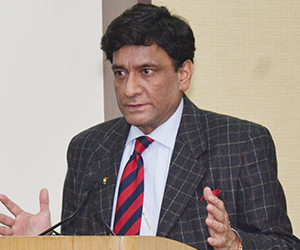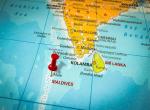It has been a busy September for India’s external relations. Prime Minister Narendra Modi has travelled to Japan, and has welcomed the Australian Prime Minister and the Chinese President in India. He has also travelled to the US, on a very high-profile visit, which seems to set it apart from all other visits from India, at least since the end of the Cold War.
To focus on the eastern direction for the moment, there have been several noteworthy departures from the past. The kind of language used in the Joint Statement issued after the talks to describe Japan is unprecedented, for a start. Modi declared that Japan was at the heart of his Look East policy. The two Prime Ministers added that the two countries had “congruent global interests, critical maritime inter-connection and growing international responsibilities”, which, along with their democratic traditions, drew them close together.
Describing defence cooperation as an important part of their strategic partnership, the leaders also identified the US 2 amphibian aircraft as a project to be worked through at an early date. All of this was intended to strengthen peace and stability in the Asia-Pacific Region and to ensure maritime security, freedom of navigation and overflights, and to promote the peaceful settlement of disputes. Further, the two countries agreed to reach out to other countries “in the region and beyond” in order to address the challenges and strengthen security.
Further, on the security aspects, there was a blunt reference in the Joint Statement to the worsening security situation among some countries, and the need for all countries to ensure the “elimination of terrorist safe havens and infrastructure.” The Statement also retained the reference – made earlier as well – to the North Korean nuclear and missile programme aimed at developing nuclear weapons and delivery systems.
Despite the obvious warmth both at the institutional and personal level, there were some areas where agreement was not possible. The first of these was the civil nuclear cooperation basket. It is reported that Japan wanted clear commitments on nuclear testing and reprocessing. It is obviously a question of finding the right formulation to allow such cooperation to go forward, since the Indian position on both is clear enough. In fact, the last Joint Statement, issued when Abe visited in January 2014, as Guest of Honour on Republic Day, carried a reference to the Comprehensive Test Ban Treaty. There was no such reference this time, which would suggest that the unilateral moratorium on testing has been accepted by Japan as the basis for further progress. There is also the issue of the Indian Nuclear Liability Law, which places responsibility on the supplier of nuclear equipment for any accidents, as against holding the operator responsible. This remains an issue with all partner-countries, though we seem to have found a way forward with the Russians. This will need to be addressed in the case of Japan as well.
One of the important issues that has been in focus for some time was the infrastructure investment that Japan was to make in India. It came through well enough, with a promise of approximately US$ 35 billion over the next five years. And in order to ensure that there are no glitches in the implementation of this sector, Modi has announced the formation of a separate body under the PMO, to consist of both Indian and Japanese officials, to work on implementing agreements in this sector.
One sector that has not got the attention it deserves in the public discourse here, though it has been under discussion for some time now, is that of LNG: there is a very welcome formulation this time – not for the first time – that the two countries will work on joint procurement, upstream development, and promoting more flexible markets for the product. It is a fact that the Asian prices for LNG are among the highest in the world, because they are linked to oil prices. This needs to be addressed, and India and Japan are among the largest importers in the world, so they can make their views count.
All things considered, this was a very successful visit, even if some of the important issues remained unresolved. To the nuclear basket, we should add the problems in the functioning of the CEPA: it has not delivered the results we expected; in fact the trade turnover has come down since it was signed. Indian medicines and agricultural products continue to face access problems. The speculation is that these are related to the ongoing negotiations on the Trans Pacific Partnership, to which Japan attaches priority.
Notwithstanding the difficulties, Modi’s visit to Japan must be rated a major success, and one can confidently expect further substantive progress in the relations, as the logic of the security cooperation makes itself felt.
This has obviously not gone unnoticed in Beijing. They have repeatedly hinted through press articles, and – less frequently – in official comment, that India should not, and would not, fall prey to the blandishments of the Japanese or the Americans. Premier Li Keqiang, during his visit in 2013, stated bluntly that India should not look to a distant relative in preference to a near neighbour. Chinese fears were obviously fed by Modi’s talk of an 18th century expansionist mindset which led some countries to occupy others’ land or enter into their waters. Though he did not name China, the Global Times concluded that Modi did “embrace some nationalist sentiment against China” and took umbrage at this remark. It pointed out that India’s GDP was one-fifth of China’s, and that Japan was in no position to provide any substantive assistance. For good measure, it added that India’s improving relations with China also provided ground for better ties between India and Pakistan – the implication being that all this could be jeopardised by India’s cosying up to the likes of Japan and the US.
Ironic, then, that Xi was compelled by the situation inside Pakistan to drop his visit to that country during his trip to the region. In fact, it would be useful to understand the setting behind the visit of Xi to India. Since the new leadership took over in spring 2013, they have paid much attention to India – Li came calling in May, making great play of the fact that this was his first visit to any foreign country. Our then Prime Minister, Manmohan Singh paid a return visit in October 2013. The Chinese Foreign Minister, Wang Yi came as Special Envoy of President Xi within two weeks of the swearing-in of the new Government in Delhi. And finally, President Xi himself came visiting in September.
At least in part, this is a reflection of the isolation in which China finds itself as a result of its aggressive approaches towards its neighbours in the western Pacific. It is also a realisation that antagonising India could well push it into the still-embryonic consensus emerging in the Asia-Pacific region – reflected in the US pivot to Asia - that collective engagement will be necessary if the rise of China is to be channelled in peaceful directions and to maintain stability in the region. Not only is China facing diplomatic difficulties, it is also facing economic and social troubles. The economy is showing reasonable headline statistics, but this is based on very shaky foundations, notably, so far as the finances and the real estate sector are concerned. Despite repeated assurances that the market will play an increasing role in the management of the economy, and that domestic consumption will lead future growth, nothing of the kind is happening, and there have been repeated financial stimuli to keep the rates of growth within target. As for social troubles, there are the current demonstrations in Hong Kong, and the running challenge to Chinese legitimacy and authority in Xinjiang and Tibet.
For these reasons, the Chinese have been reaching out to India. The gestures of the new leaders have been stronger than before: as noted, Premier Li Keqiang made great play of the fact that India was the first country he was visiting after taking over the job. Wang Yi, the Foreign Minister, was the first of the visitors from any of the P5 countries to visit India after the new Government took office in Delhi. This was the background to the visit of Xi himself.
Reconstructing the messaging that goes on around such visits is important. There is the non-verbal element, which the Chinese have been doing for decades now. It began when Vajpayee was in Beijing as Foreign Minister, in 1979. The Chinese invaded Vietnam while he was in China, forcing him to cut short the visit. In like fashion, the Chinese greeted President Venkataraman with a nuclear test. This was the first ever visit by an Indian President, and India was then a non-nuclear weapon state. And, of course, memories are still fresh of the intrusion and the pitching of tents in Depsang just prior to Premier Li’s visit in May 2013.
In line with this pattern, the visit of President Xi was preceded by large-scale intrusions and confrontation in the Chumar area of southern Ladakh. But this time, the Indian non-verbal messaging took a different form: the Tibetans were allowed to demonstrate openly, and at the venues where Xi was to be present, notably at Hyderabad House and the Taj Palace. And these were covered by all the TV channels. The past practice had been to disallow any demonstrations near where the Chinese dignitary was to be present, coupled with keeping the news outlets away from the demonstrations. In addition, the Indian Army also moved over a thousand troops to the area of confrontation.
There were also noteworthy aspects to the verbal messaging. At the press briefing after the talks on 18 September, there was an unusual formulation used by PM Modi. And he used it not once, but twice, in his prepared statement to the media. Right at the start, he said that neighbours, including China, were his priority, and
Therefore, a climate of mutual trust and confidence; respect for each other's sensitivities and concerns; and, peace and stability in our relations and along our borders are essential for us to realize the enormous potential in our relations.
A little later in the statement, he added that
...peace and tranquility in the border region constitutes an essential foundation for mutual trust and confidence and for realizing the full potential of our relationship.
What is unusual is that the posture we have adopted since the resumed engagement in 1988 has been that we should not allow the territorial issue to get in the way of normal relations in other areas. The form of words used by PM Modi seems to suggest that the overall relations were hitting against the border problem, and it needed to be addressed. He suggested that the way forward was for the two countries to clarify the Line of Actual Control [LAC] and to work to settle the border itself.
Since 2003, the Chinese have put aside the LAC clarification, even though the 1996 Agreement on CBMs in the Border Areas along the LAC requires both countries to do precisely this. But Xi did not answer this point in his reply, implying instead that border incidents would continue. And, of course, on the border, they have always stressed that this is an issue left over from history, and will require patience to resolve. This is where Xi used a slightly different formulation, which deserves to be quoted in extenso:
The China-India boundary question is an issue left over from history. Over many years, the two sides have made steady and positive progress in their boundary negotiations, through friendly consultations. The China-India border areas have maintained peace and tranquility. Yet, since the border has yet to be demarcated, sometimes there might be certain incidents. But the two sides are fully capable of acting promptly to effectively manage the situation through various levels of border-related mechanisms, so that such incidents do not have a large impact on the bilateral relationship.
China has the determination to work with India through friendly consultations to settle the boundary question at an early date. We also have the sincerity to work with India to maintain peace and tranquility in the border areas before we are able to finally settle the boundary question. [Emphasis added]
This is unusual in that there is no reference to the need for patience or the need to find a fair and balanced solution, which is the staple formula; instead, he says that China is determined to settle the issue at an early date. There was more to come, which suggests that Xi’s choice of words did not play well with everyone back in Beijing. Although Xinhua, and the People’s Daily, in their reports on the press conference, retained this formulation, the Global Times, in its version, dropped the reference to the phrase “at an early date”. Throughout the day [18 September] there were varying versions of the news reports that played out in the different news outlets, including one that even attributed this turn of phrase to Modi!
Finally, there was closure on this issue only after Xi returned home, and Foreign Minister Wang Yi gave the Party line to Xinhua, which retained the formulation “at an early date”. This was then dutifully carried in full, without change, by all the papers, including the more nationalist-minded Global Times.
This suggests two things. The first is that there are differences in the leadership over some of the critical issues, and these are serious enough to play out in the media. To those who would doubt this, we actually have evidence from another area – Hong Kong. And it again involves the Global Times. It was this paper that carried a report to the effect that the PLA was ready to keep the situation in Hong Kong under control, a report that was removed soon after it appeared.
It also suggests that Xi is not quite as sovereign within China as most believe. Why this is important for India is that most analysts believe – as did the present writer – that the PLA intrusions are stage-managed to coincide with high-level visits. And yet, this one time might just be the exception, and not choreographed: it is also reported that Xi assured Modi that he had nothing to do with, indeed had no knowledge of, the intrusions.
Would India figure so importantly as to be a subject of discord? There is, of necessity, a value judgement involved here. But we can take one more fact into account which may shed some more light. This is the removal of the former Ambassador, Wei Wei, to India just weeks before the visit was due. He was replaced by an official enjoying the rank of Vice Minister, Le Yucheng, who had been serving in Kazakhstan, where his own tenure was cut short. He presented his credentials just days before the visit. The former Ambassador’s new assignment is not known. It may be worth emphasising that Wei was appointed to the India job in January 2013, well after Xi had taken over as Party chief, and was to take over as President at the next meeting of the National People’s Congress.
Lending some further support to this hypothesis is the fact that after his return to Beijing, Xi addressed the PLA Chiefs of Staff, where he delivered some cautionary remarks to the assembled officers. This news got a lot of play in India for the remark that the Army should be prepared to win a local [regional] war in the age of information technology. In point of fact, this formulation is not new, and has been in use for a decade or more. This does not mean it is not serious, or that we in India can ignore this. No, we need to be fully prepared for any escalation that the Chinese might undertake in the border areas. But this is not a sign that military action against India is imminent.
However, there were new elements in the speech and these related to the need for absolutely loyalty to and firm faith in the Party, and to the need to ensure “a smooth chain of command and make sure all decisions from the central leadership are fully implemented”. For good measure, Xi added that, “Military commanders should have a better understanding of international and domestic security situations”. Clearly, he is warning the PLA senior echelons that the international and domestic situation is not as favourable to China as many in that country are wont to believe and should, therefore, trust the judgement of the Party leadership.
These are glimpses into the workings of the new leadership and its internal balance, and some of the thoughts expressed by Xi will need to be checked against delivery, particularly regarding a border settlement. But it is important to be aware of the different strands within China. Twice – at least twice – before, we have missed the import of such changes and hints at a settlement, once under Zhou Enlai and then under Deng Xiaoping; it would be a pity if we were to miss another chance.
This idea, that there was a new push behind the border settlement is reinforced by a comparison of the formulations used in the joint documents this time, and the previous one, when PM Manmohan Singh visited China in October 2013. In that document, there was a bland reference to encouraging the Special Representatives to explore the framework of a settlement. This time, the wording offers more of a commitment, not to exploring for a framework [which already exists, since 2005], but to an early settlement as a strategic objective. Therefore, the opening that has seemingly been offered needs to be vigorously pursued. Vigorously pursued but with a clear understanding that there are daunting problems along the way, even with the best of goodwill, which is by no means assured.
For the rest, some of the other noteworthy aspects of the visit are worth mentioning in brief. The decision to begin discussions on civil nuclear cooperation is an important and positive development. This is so not because there is great commercial scope in this area, but that China has so far refused to have any dialogue with us on nuclear issues because that might lead to at least an implicit recognition of our weapons programme. Even though they did reluctantly agree to the NSG waiver, and this implies recognition of our possessing nuclear weapons, this is a welcome additional step. It may even, over time, persuade China to stop blocking Indian membership of the NSG itself.
One of the other things that Xi mentioned was that China was willing to accept an expansion in the membership of the Shanghai Cooperation Organisation [SCO], and to include India, which it had been resisting doing so far. While saying this, he added that he expected India to help build its [China’s] relations with SAARC. In the Maldives and Sri Lanka, Xi was more forthright on this latter aspect, saying that he expected them to help “upgrade” [“enhance” in the case of Sri Lanka] its relations with SAARC. What the idea is behind this formulation is not clear – Chinese scholars deny that China seeks full membership of SAARC.
Another proposal that was more in evidence in the other two SAARC countries that he visited, than in India, was the Maritime Silk Road. Perhaps this was in deference to the well-known Indian doubts about the idea, even though it is one that Xi claims personal ownership of. But he did get satisfaction, even if not in full measure, on the Bangladesh-China-India-Myanmar [BCIM] corridor.
There was an unforced error in the drafting of the Joint Statement though. This was the reference to the “Tibet autonomous Region of the People’s Republic of China” in the context of the opening of an alternate route for pilgrims going to Kailash-Mansarovar. Such a reference has been absent in our joint documents for some years now, from 2010. Even last year, when the issue of the pilgrimage to K-M was reflected in the joint document, the formulation used was that the “Indian side conveyed appreciation to the Chinese side”.
In between, there was the visit of the Australian Prime Minister, Tony Abbott. Australia will be hosting the G 20 Summit in Brisbane in November, and this was a useful pre-Summit meeting for the two Prime Ministers to get acquainted. For obvious reasons, the visit was low-key in comparison to the other two visits, but it yielded a formal agreement, reflected in the Joint Statement, on supplies of Uranium to India. Australia has some 35% of the global reserves of the element, and was initially reluctant to supply to India, because of NPT-related issues. However, these have now been set aside, and hopefully, trade in Uranium can begin. Another important area of agreement relates to the sale of LNG from Australia. India’s needs are growing, and the pipeline projects around our periphery – TAPI and IPI – are going nowhere in a hurry; nor should we be particularly keen to allow Pakistan to sit astride our energy lifelines. In such a situation, LNG is the best and most flexible option, with Australia being one of the viable alternatives for us, in addition to the Persian Gulf suppliers.
A quick round-up of the regional and global issues that touch India suggests quite clearly that, of the three, it is Japan that is most in harmony with Indian views and interests. This is most obvious in the case of the UN Security Council reform, where both countries are claimants to permanent seats, and are working together; China is the most reluctant to offer support on this.
On terrorism, similarly, it is Japan that is willing to call for the dismantling of safe havens and infrastructure, while Australia and China are reluctant to make such a reference out of deference to Pakistani sentiments.
On civil nuclear cooperation, all three are reluctant partners, but Australia has shown the greatest willingness to meet Indian interests, and is also in a position to take specific steps to actualise this cooperation. Japan and China are both taking some hesitant steps, and it remains to be seen what the outcome of the talks with these two countries will be.
Probably the sharpest differentiation happens over the Asia-Pacific Region. India and Japan have no hesitation in calling for stability, freedom of navigation and overflight, and the importance of international law in governing dispute settlement. China obviously is equally against any such formulations, and Australia, out of deference to China, also refrains from too clear a formulation on this issue. It prefers, instead, to talk about the dynamics of the region being underpinned by a “cooperative mechanism”.
Afghanistan, an issue that we shall hear more of going forward, is another issue where India and Japan share similar views. We both agree that Afghanistan should develop as an independent country, free from external interference. For obvious reasons, China will have nothing to do with such a postulate. For less obvious reasons, Australia too is reluctant to sign up to such a demand, even though it had soldiers in the country, and suffered as a result of such interference.
Different strokes for different folks...
Published Date: 9th October 2014, Image source: http://news.oneindia.in










Post new comment